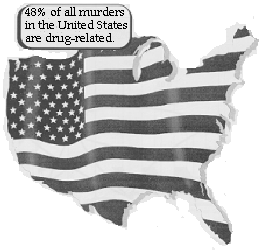Drug Enforcement Administration
Briefing Book
![]() DRCNet Response to the
DRCNet Response to the
Drug Enforcement Administration
Briefing Book
| DEA Statement | Response |
| The United States is the undisputed leader among developed countries in rates of homicide, according to the Journal of the American Medical Association. Americans today stand a greater chance of being a victim of violent crime than of being injured in an auto accident. Through the flurry of statistics that every year proclaim either a rise or a fall in crime, several trends have remained constant. | The reader will note that, once again, the DEA fails to properly distinguish the causes of violent crime. |
| Violent Drug Gangs |
|
|
Like alcohol prohibition in the 1920s, this is simply the natural result of prohibition and attempts to enforce it. |
|
Why? Because of the tremendous profits in the prohibited drug trade. It offers an easy path to riches for unscrupulous and violent people -- just like Al Capone in the 1920s. |
|
Just like Al Capone in the 1920s. |
|
No, the main reason for the proliferation of these gangs and their violence is the tremendous profits which come from a prohibited drug trade -- just like Al Capone in the 1920s. |
|
This is precisely the same sort of pattern that happened in the 1920s during alcohol prohibition and ultimately led to its repeal. See, for example, Repealing National Prohibition. |
 |
|
|
Just like Al Capone in the 1920s. |
|
Just like Al Capone in the 1920s. |
|
Again, what the DEA fails to tell you is that the "drug-related"
murders stem from two primary causes: 1) alcohol 2) the tremendous profits from the illegal drug trade -- a direct result of an unsuccessful prohibition. See Psychoactive Substances and Violence, by the US Department of Justice. |
Travel back to the DRCNet Response to the DEA Home Page
Travel back to the DRCNet List of DEA Publications
Travel back to the Table of Contents